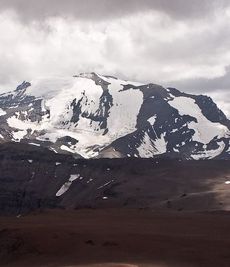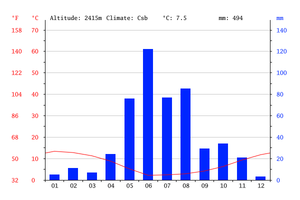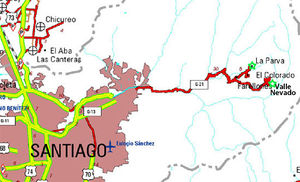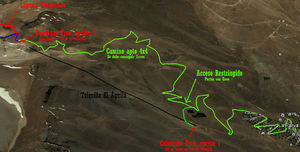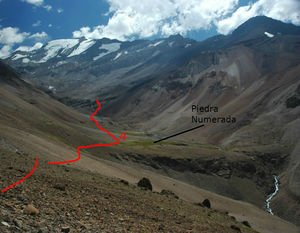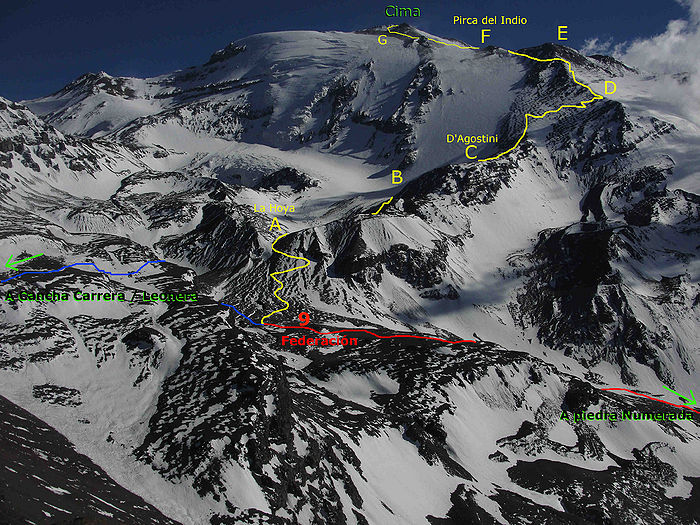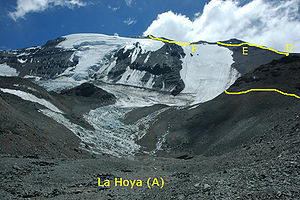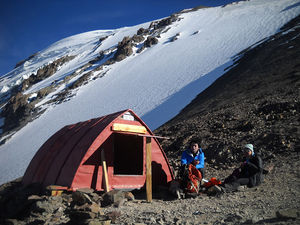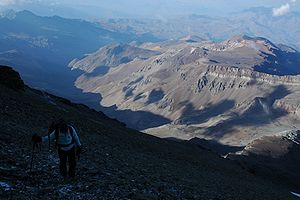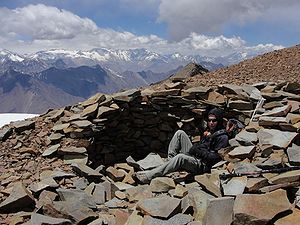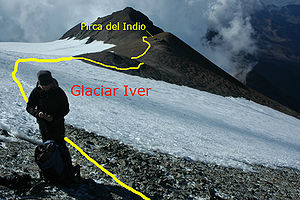Diferencia entre revisiones de «ENG:Cerro El Plomo»
m (Texto reemplazado: «|Actividad=Trekking» por «|Actividad=Montaña») |
m (Texto reemplazado: «|TipoTrek=Ascensión Cerro Category:Cumbre» por «|TipoTrek=Ascensión Cerro») |
||
| Línea 14: | Línea 14: | ||
|Señalizacion=Inexistente | |Señalizacion=Inexistente | ||
|Infraestructura=Refugio(s) | |Infraestructura=Refugio(s) | ||
| − | |TipoTrek=Ascensión Cerro | + | |TipoTrek=Ascensión Cerro |
|ComparteIdayRetorno=Ida y Retorno por la misma ruta | |ComparteIdayRetorno=Ida y Retorno por la misma ruta | ||
|Imágen Principal=Cerro el Plomo.JPG | |Imágen Principal=Cerro el Plomo.JPG | ||
Revisión del 18:51 27 abr 2017

|
|
| |||||||||||||||||||||||||||||||||||||||||||||||||||||||||||||||||||||
 Not to be confused with Nevado el Plomo, a sixthousand far less visited Not to be confused with Nevado el Plomo, a sixthousand far less visited
|
In a Nutshell
“El Plomo” is without a doubt Santiago’s most emblematic mountain and one of the most imposing of the central valley. With its grand size it can be seen from anywhere in the Santiago valley. It is the city’s great guardian. Every time you look up you can see it as the background curtain of The Andes. Sacred Mountain for the Incas and place of initiation for many mountaineers in Chile, it is definitely a “must-see” and should be visited at least once, especially by those who live in Santiago. Guaranteed:
- Live the “High Andes” experience
- Imposing views of the central Andes and the Santiago valley
- Stunning Colgante Glacier (“Hanging Glacier)

When to visit
- Mountaineering: Between November and April. Summer weekends can get crowded, so if you’re looking for a wild high mountain experience, either choose a different destination or visit on a weekday.
- Ski Touring: From June to generally the first half of October.
Access
By car
From Santiago, take the paved road G-21 towards the ski centers and “Los Bronces” mine. Distance is 15,8 km towards the fork that leads to the mine, measured from Terpel gas station which is located at the end of Las Condes Av (meeting ground for skiers, cyclists, and mountaineers that venture into the valley). Take a right at the fork and continue on a very narrow paved road that abruptly ascends on closed curves. Road protection is poor and you should drive with caution especially during the winter months. An additional 16km on this mountain road will take you to the town of Farellones, on curve 40, 32km from Santiago. From Farellones, it is 13km more on a road that ascends many more curves up to the 3025 AMSL of Valle Nevado hotel, where there is a spacious parking lot.
By public transportation
During the ski season (mid June to the end of September), the following companies make the trip:
- SNOWTOURS
- Address: Huerfanos 502, next to Santa Lucia hill, Bellas Artes neighbourhood, near Santa Lucia (red line 1) and Bellas Artes (green line 5) metro stations
- Phone: (2) 2982 8200 - (2) 3216 1106 - Whatsapp: +569 7997 3170
- reservas@snowtours.cl
- Departures from: Airport, Downtown Santiago (on Huerfanos and Santa Lucia), hotels and other spots.
- They also do trips from the airport to downtown, vineyard tours, Valparaiso and Vina del Mar, Isla Negra and other spots.
They are the cheapest and leave the earliest. It is very easy to get to them and their meeting spots
- KL Adventure
- Address: Santa Isabel Supermarket Cantagallo, Las Condes, Santiago
- Fono: (2) 217 91 01
- Departures from: Airport, Santa Isabel Supermarket Cantagallo, Ski Rental.
They are located almost at the entrance of the road to the ski centers, service is only from the hotel.
- Ski Total
- Address: Avda. Apoquindo 4900 Local 37-46 (Omnium building), Santiago
- Phone: (2) 246 68 81
- Departures from: Omnium building, Santa Isabel Supermarket Cantagallo, Los Trapenses mall.
Route Description
You can start on this route from Valle Nevado or La Parva. Kilometer 0 on the description (not the altitude profile) has been defined as the point where these two paths join and correspond to the dam located on Tres Puntas ski piste in Valle Nevado.
Stretch 1 : Valle Nevado option - Dam
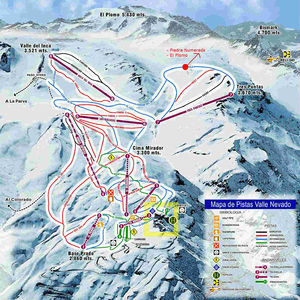
On the car path
Either by foot or by 4x4, the route starts at the hotel itself. You go on a narrow pass to the left of the hote, turn right immediately after, and take the route that ascends the mountain. It will make a curve and continue on the left hillside. You will find other routes that descend to the left and routes that ascend to the right, but you must continue on the same path until reaching the high part of the mountain ridge shared with the hotel. You can also recognize it because the “El Mirador” ski lift ends in this area. From here you must go down on the path that will take you to a small dam to the north (do not mistake for the dam you can see to the south). Immediately after the dam you will reach a fork, from here there is a path to the right (east) that ends in the Tres Puntas rope tow lift 100 meters further. Basically, you should follow this rope tow lift but not on this path. To take the correct path you must turn left at the fork, advance 150 meters, cross a small creek and then continue east. The path makes a small zigzag, moves to the valley of the Tres Puntas rope tow and continues on its hillside until reaching a great dam. Here is where the adventure begins.
Stretch 1: La Parva Option - Dam
La Parva Ski Center – Piuquenes or Franciscano lagoon The route begins at La Parva ski center. The first stretch passes through the ski pistes up to Piuquenes lagoon (which stands a little over 3,600 AMSL). To get to the top of the “Las Aguilas” ski lift from the ski centers , there are various options. By Foot: Walking on the ski pistes (or on the car path) up to the end of “Las Aguilas” ski lift (3,555 AMSL) By Car (November or December through May)
You must get to the highest street of La Parva (called Emillie Allais) and 100 meters after it ends, take the dirt road to the right. This road will take you on 1.8 km of gravel in good condition up to the parking lot called “Campamento Base” (Base Camp) located at an altitude of 2.980 AMSL. You can request the key to the gate that blocks the way further on the Base Camp area and continue by car on a dirt road in decent state up to the end of the Las Aguilas ski lift. The key must be requested at La Parva headquarters located in the same town, next to the little church. You must leave your ID for them to hold until you return the key. We recommend to first call the number +56222209530. Please keep in mind that they would be doing you a favor and it’s not their obligation. There are many forks on this road, so we recommend carrying the green route on the map.
Ski Lift
Las Aguilas ski lift works during the summer weekends. For the 2016 season, the price of the ticket for mountaineers are as follows : Both ways for a total of $10.000 CLP, and one way is $6.500. More info on this on La Parva It is advisable to check the dates for which you intend to visit the center, since something could happen that could drag the process of buying the ticket. This way you can anticipate the mishap and avoid wasting precious time on a bureaucratic process.
Between the months of June and end of September, during the ski season, there are no specially priced tickets for mountaineers, so you would have to pay full price ($45.000 CLP on 2016). You would take the Flores lift and then Las Aguilas.
The shelter at the the top of Las Aguilas lift, where these three routes lead to, is 50 meters lower than Piuquenes or Franciscano lagoon, so the lagoon is reached with just an additional 20 minutes by foot. As a reference, consider the Falsa Parva mountain (3,999 AMSL), whose base finds both the ski lift shelter as well as the lagoon. From the shelter you must keep walking on the car path which goes East. After an additional 100 meters, turn left traversing a little 30 meter hill with clearly marked paths. Once the col has been reached, you can admire the Piuquenes lagoon at a very close distanace. Piuquenes Lagoon – Dam
Stretch 2: Dam - Piedra Numerada

Meeting Point for Valle Nevado and La Parva paths
Altitude: 3.550 AMSL | Km:0
Upon reaching this area of the dam, you must continue on the path that descends the hillside in direction to the northeast, or in other words, to the creek and green valley.
Creek (Point 2)
Altitude: 3.425 AMSL | Km:1
You will reach a small creek of crystal clear water (ok to drink), which is a good spot to fill up. After crossing the creek, the path begins to ascend. You must skip through rocks which during the winter will creep from under the snow. After 1,1km and a 90m altitude difference, you will reach the highest part of the hill: a nice overlook of the Cepo valley. First Lookout Point (Point 3) Altitude: 3.512 AMSL | Km:2,1 From this point you can clearly see the Cepo river valley and the impressive glaciers of “El Plomo” on the background. The vegetated plateau on the Cepo river bed up the valley, belongs to “Piedra Numerada”, a very good spot for camping. Immediately after this flat, you will see rocky walls that mark its abrupt south border. You must continue on the path that now has a north direction and softly descends.
Detour to “Piedra Numerada” (Point 4)
Altitude: 3.407 AMSL | Km:3,8
You have arrived to the wetlands of “Piedra Numerada”, a peaceful valley with plenty of water and vegetation. If you would like to go to the camping area you must abandon the path and walk towards the center of the wetland, where you will find good camping spots. If you wish to keep going towards “Federación” you must continue on the path with direction to the north.
Piedra Numerada from the first lookout. Point 2 on the map After Piedra Numerada, the path is flat and easy to travel, you will pass some small creeks and after 800 meters, you will reach the Cepo river.
Cepo river crossing (Point 5)
Altitude: 3.450 AMSL | Km:4,6
You must cross the Cepo river in a place where the river is divided in two arms, which makes it easier to cross. The river is not deep and shouldn’t be dangerous. If you take the time to search for an easy crossing, you won’t even have to take your shoes off. Due to the rocks of the river bed, the path fades here, but after crossing both arms you can easily find it again. After crossing, the path switches hillside and ascends, and after 700 meters (50 vertical), you will reach the high point of a waterfall that feeds the Cepo river.
Waterfall and Overlook (Point 6) Altitude: 3.608 AMSL | Km:5,4
From this point you can see the Cepo river in all its glory, and El Plomo and its glaciers are now seen from very close distance. From here, the path softly ascends for 900 meters until it is interrupted by a steep slope (Point 7), the path turns towards the east and begins to ascend a small hill in a more demanding zigzag. This will go on for 800 meters and you will have ascended 170 vertical meters after which you will reach a large and flat valley.
Plain (Point 8) Altitude: 3.930 AMSL | Km:7,1
Upon reaching the plateau you must continue for 600 meters of easy walk with little incline. Some small creeks cross the path, these dry at the end of summer. The plain is interrupted by a small hill that should be ascended on its right side (north). After 800 meters of walking (130m vertically) you will reach the area of “Federacion”, which is easily recognized by a red shelter for public use that sleeps 4 people.
Federación (Point 9) Altitude: 4.145 AMSL | Km:8,5
Along with La Hoya, Federacion is one of the possible camping spots for those who venture into the summit of El Plomo. It is located at the end of the Cepo river valley, and is protected from the wind by rock walls, La Leonera and El Plomo peaks. One hundred meters up the valley there is a small glacier that provides water to the campsite. It freezes during the night so we recommend filling up as soon as you reach Federacion.
Stretch 3: Ascending
(Note: Starting at this point, you can also opt to climb Punta Santiago, a less ambitious goal than El Plomo, or use it as an acclimation step before attempting to reach the summit of El Plomo)
From Federacion you must leave the valley you were on, and zigzag the north hillside towards El Plomo. After 20-30 minutes on the hillside, you will reach a flat with some lagoons. This area is known as “La Hoya”.
La Hoya (Point A)
Altitude: 4.292 AMSL | Km:9.1
This is another good spot for a base camp. It has spectacular views of the Colgante (hanging) and Iver glaciers, and good access to water. You can enjoy an obstruction-free view of El Plomo. While this camp is closer to the summit of El Plomo than Federacion, it is also more exposed to the wind, altitude, and the cold. If you are not well acclimated, camping here is not advisable, and it might be better to make an additional physical effort on the day you intend to reach the summit.
You must continue on the right (east) of La Hoya valley. In the beginning, this route gains altitude abruptly until reaching a small ridge after 300 meters. Here the route turns towards the north, nearing the slopes of El Plomo. In this area the incline is reduced and the pace is picked up. On the left (west) you can see the Iver Glacier and La Hoya valley slightly below. 1 km after leaving La Hoya you will reach the foot of Iver Glacier’s ice wall.
Iver Glacier Lookout Point (Point B)
Altitude: 4.531 AMSL | Km:10.1
A great overlook of the Iver and Colgante glaciers and La Hoya valley. This path turns towards the east, and begins a marked ascent on a zigzag that will continue until reaching the ridge. Here you can see D’Agostini shelter at a close distance.
D'Agostini Shelter (Point C)
Altitude: 4.620 AMSL | Km:10.5
Wood shelter built by the “Federación de Andinismo” (federation of mountaineering) which has been recently reconditioned and can sleep a maximum of 4 people. There is no running water but usually there is snow to melt. It is exposed to the wind. It is not advisable to choose Agostini for a campsite to attempt the summit of El Plomo. It would be better to have a 1 hour and 15 minute longer summit day but with a better sleep from the night before and being less worn out from the previous day (going up carrying weight from Federacion to Agostini signifies a considerable effort). That being said, Agostini is a good spot to sleep to help acclimate for higher peaks (6 thousands). A tiring route of loose rock begins at the shelter, with plenty of intercrossed prints and considerable incline. It is shady in the morning as it is the North face. You must ascend in direction towards the east until reaching the ridge.
Ridge (Point D)
Altitude: 4.850 AMSL | Km:11.2
Once on the ridge you can again enjoy the morning sun rays and enjoy the view from the heights of the valley. It is a good spot to apply sunscreen and put on your hat and sunglasses. Now you must change direction and head north on the ridge directly towards El Plomo. The incline is significant here but the terrain is firm and rocky. You must pass an area of rocks in the middle of the ridge on the east side (right). Due to the terrain’s rockiness, the print will begin to fade. It is intuitive to continue on the same direction as before but here the path abandones the ridge on its west face (left).
Detour leaving the ridge (Point E)
Altitude: 5.032 AMSL | Km:11.6
This detour is not totally clear and as many mountaineers miss this point, the path that continues on and passes it is almost more noticeable. Follow this rule: When the path begins to fade, start looking for a path on the left side of the ridge. If you make a mistake here and pass this point, it wouldn’t be so terrible as these two paths meet at Pirca del Indio, but the correct route is easier to follow.
Having left the ridge, you must do a small traverse. You will then gain altitude on a gorge that will leave you on a plateau. You must keep going towards the glacier, and just before the glacier you will reach Pirca del indio.
Pirca del Indio / Iver Glacier Crossing (Point F)
Altitude: 5.200 AMSL | Km:12.1
Over a stone dome there is a stone wall of considerable size that serves as protection from the wind and place to rest. Here on 1954, an expedition led by Guillermo Chacón, found a boy of 8 or 9 years of age perfectly preserved, with no signs of injury and with a peaceful face. His death dates back to 500 or 600 years ago. Freezing is what most likely caused his death. Due to the cold and layers of snow, ice, and rock the body was able to withstand the course of centuries without going through the natural decomposition. The body is currently in the National Museum of Natural History of Santiago, although it is not on exhibition. La Pirca del Indio is an excellent spot to rest and take a break before starting the last stretch of El Plomo. It is also a good place to get out your ice axe and crampons to cross the 50 meters of Iver Glacier.
The crossing of Iver Glacier corresponds to the Crux, the most technical part of the route. Even though it is a narrow crossing (50 meters) with a relatively small incline and free of crevasses, there are times when the ice is very hard and smooth and not having the proper equipment (ice ax and crampons) might make the difference between falling and sliding to the point where the incline gets more pronounced. After this point you will face a 650 meter drop that will continue until reaching the level of La Hoya.
A rope and harness are unnecessary except to protect somebody that is not yet comfortable with autostopping techniques with the ice axe. After crossing the glacier you can put your equipment away since you won’t need it until the return. The path continues to ascend on an easy incline with a northwest direction for about 20 minutes until reaching some towers that appear to be the Summit.
Final Ascent (Point G)
Altitude: 5.364 AMSL | Km:12.7
The path now turns towards the east and presents a lose rock terrain for 10-15 minutes (last obstacle) which will leave you on the plateau of the summit.
False Peaks (Point H)
Altitude: 5.410 AMSL | Km:12.8
This plateau is a good spot to put on warm clothes. The summit is very near and the wind blows strong and often. The summit is at the other end of this large plateau, so you should continue in direction to the east for 450 more meters (5-10 minutes). An iron cross marks the summit.
Summit
Altitude: 5.440 AMSL | Km:13.3
From the summit you can see the entire valley of Santiago, and Leonera and Altar peaks on the foreground. You can easily distinguish the high peaks of the central mountain range.
Return to Federación
To return to Federacion you should follow the same path in the opposite direction and THIS should take about 2 hours. You must take the same precautions crossing the glacier, specially if the ice is hard and smooth.
Return to Santiago
There are two options to return to Santiago from Federacion:
- Go back on the same route that was described in this description (Dam – Piedra Numerada)
- Go back via Cancha Carrera – Co Pintor – Falsa Parva (False Parva) described in Travesía Federación - Cancha de Carreras. A large stretch of this last option takes place on plateaus and ridges with great panoramic views. Strongly recommended!
Weather forecast
Permits | Fees
Fortunately, still no permit or fee is required to know the area or climb its summits. However, Valle Nevado demands to inform in advance of the visit, in order to keep a log:
- E-mail: lsepulveda@vallenevado.com
- Phone: +56224777000
- Free.
Through La Parva, on the contrary, there is no control whatsoever.
Photo gallery
Trail, by José Guridi
Cerro El Plomo and Cerro Altar from Santiago.
Cerro El Plomo, Nevado Juncal and Nevado El Plomo from the summit of Piuquencillo. Looking north, august 2002
Cerro El Plomo and Leonera from Piuquencillo. August 2002
To see the full list of 691 routes of trekking and mountain climbing in Chile in spanish, click here
| ||||
| Trekking Atacama | ||||
| Trekking Norte Chico | ||||
| Trekkings: | ||||
| Cumbres: | ||||
| Trekkings: | ||||
| Cumbres: | ▲ ENG:Cerro El Plomo | |||
| Trekkings: | ||||
| Cumbres: | ||||
| Trekkings: |
| |||
| Cumbres: | ||||
| Trekking Rancagua | ||||
| Trekking San Fernando | ||||
| Trekking Curicó | ||||
| Trekking Talca | ||||
| Trekking Linares | ||||
| Trekking Chillán | ||||
| Trekking Concepción | ||||
| Trekking Los Angeles |
| |||
| Trekking Zona lacustre | Trekking Temuco | |||
| Trekking Valdivia | ||||
| Trekking Osorno | ||||
| Trekking Puerto Montt | ||||
| Trekking Chiloé | ||||
| Trekking Patagonia | Trekking Chaitén | |||
| Trekking Coyhaique | ||||
| Trekking Cochrane y Villa O`Higgins | ||||
| Trekking Puerto Natales | ||||
| Trekking Punta Arenas | ||||
| Trekking Tierra del Fuego | ||||
| Trekking Isla de Pascua | ||||
| Trekking Archipiélago Juan Fernández | ||||



